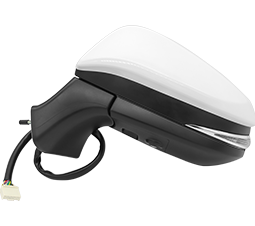2025-11-04
Heated auto side mirrors are a common feature on modern cars and a popular aftermarket upgrade. Drivers expect them to remove fog and ice and to improve visibility quickly on cold or damp mornings. But do they really work as advertised? This article gives a practical, technically grounded answer: how mirror heating works, what it can and cannot do, factors that affect performance, electrical and safety considerations, maintenance advice, and selection guidance for OEM and aftermarket systems.
Most heated side mirrors use a thin resistive heating element bonded behind the reflective glass or integrated into the glass backing. When the vehicle supplies voltage, current flows through that element and generates heat by Joule effect. The heat raises the mirror surface temperature enough to evaporate condensation or melt thin layers of frost. Some systems are wired to the rear defroster circuit or to a dedicated switch; advanced systems employ temperature sensors and timed cycles to avoid excessive power use.
There are two practical implementations: visible grid or wire elements adhered to the glass, and opaque thin-film heaters applied beneath the glass backing. Grid or wire heaters are easy to service but slightly reduce optical clarity when observed at shallow angles. Thin-film heaters are nearly invisible and give more uniform heat distribution but require replacement of the entire mirror unit if damaged.
Heated mirrors are very effective at removing or preventing condensation and light frost because the amount of thermal energy required to raise the glass above its dew point or melt a thin layer of ice is modest. However, their performance drops with heavy, thick ice buildup or when wind continuously removes the warm boundary layer. In these harsher conditions, heating helps but usually needs to be combined with mechanical de-icing or an engine heater for rapid results.
Several factors determine real-world heating speed: the heater power (watts), mirror glass area and thickness, ambient temperature and humidity, wind chill from vehicle motion, and whether the mirror enclosure provides insulation. Vehicles that tie mirror heating to engine-off cycles may not deliver continuous power, reducing effectiveness when the vehicle is parked.
Set realistic expectations: heated mirrors remove fog and melt light frost in minutes, improving safety and convenience. They do not instantly clear heavy ice, large snow accumulations, or road grime. Additionally, if the mirror glass is pitted, scratched, or hydrophobic-coated, heating may be slower or uneven. For parked cars in sub-zero conditions, electric mirror heaters that remain powered when ignition is off perform best, but such systems may require separate timers to avoid battery drain.
Typical mirror heaters draw modest current — often in the 5–15 watt range per mirror for OEM thin-film types and up to 30–40 watts for higher-power aftermarket pads. When combined with rear window defrosters and heated seats, total accessory load can rise significantly during cold starts. Manufacturers manage this by using timed relays, sensing alternator output, or integrating heaters into the vehicle’s thermal management logic to prevent battery discharge.
If battery health is a concern, engage mirror heating only when needed, avoid running multiple high-draw accessories unattended with engine off, and consider vehicles with automatic power management that disable nonessential loads when battery voltage drops. For fleet vehicles operating in extreme climates, spec’ing vehicles with higher-capacity alternators or auxiliary battery systems reduces risk.
Heated mirrors require little maintenance but occasional checks keep them reliable. If a mirror fails to heat, common causes include a blown fuse, a faulty relay, damaged heating element, or poor electrical connection in the mirror harness. For thin-film or bonded heaters, the entire mirror may need replacement if the heater delaminates or the conductive traces break.
| Feature | OEM Integrated Heater | Aftermarket Pad/Film |
| Integration | Seamless, often tied to defroster | Requires wiring and switch or relay |
| Appearance | Invisible or factory-finished | May be visible or add slight haze |
| Serviceability | OEM parts replace mirror assembly | Pads can be replaced independently |
Heated auto side mirrors do work for their intended purpose: removing condensation and light frost and significantly improving safety and convenience in many climates. Their limitations are predictable — they are not a magic cure for heavy ice or snow. For best results, rely on OEM-integrated heaters when possible, keep electrical systems healthy, and combine mirror heating with basic winter practices like clearing thick ice before relying on the heater and using a vehicle-level defrost strategy. For older vehicles, a professionally installed aftermarket kit can be effective if wired correctly and protected by a dedicated fuse or relay.
